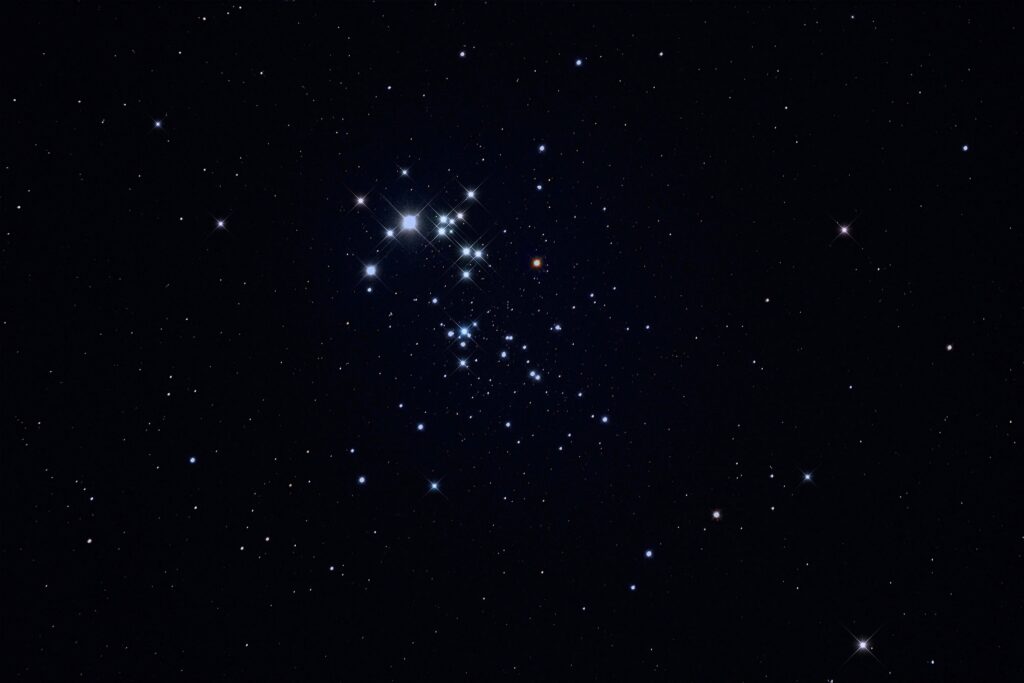NGC 457 is an "open star cluster" in a star rich section of the Milky Way in the constellation Cassiopeia. Its distance, based on an examination of Cepheid variable stars, is 8,500 light years (2.6 kpc). It is a difficult task to differentiate stars that are cluster members from other stars in the field, but recent studies suggest that the stellar population is 100-150 stars (one study refers to 113 "probable members," including 31 variable stars). The apparent width of the cluster is 20 arcminutes, corresponding to two-thirds the angular width of a full Moon. However, it is not visible without binoculars or a telescope due to its distance from us.
NGC 457 was discovered in 1787 by English astronomer William Hershel. Soon after its discovery it was popularly known as the "Owl Nebula," but in more recent years it is more often referred to as the "E.T. Cluster" due to a resemblance to the movie character.
The brightest star in the image (Phi Cassiopeia) was long thought to be a cluster member. If so, its luminosity at a distance of 8,500 light years would make it one of the brightest known stars. More recent examination suggests that it is a foreground star that appears to lie within the cluster because it is located on the same line of sight as the cluster from our perspective. The best evidence now places this star only 2,300 light years away, or about one-fourth the distance to the cluster.
Also noteworthy is the large red star in the middle of the cluster. This is HD 236697, an 8th magnitude "red giant" star several thousands of times larger than our Sun. It is spectral class M, which corresponds to stars that have a low surface temperature, in this case due to the vast expansion of the star which causes the surface temperature to drop and makes the star appear red. Cooler stars are redder due to the fact that the photons they emit are less energetic, have a slower frequency, and a longer wavelength that the human eye perceives as red (600 nanometers).
The "E.T. Cluster" in Cassiopeia
Date Taken:October 8, 2013
Location Taken: Conditions of Location:mag 4.5 sky, FWHM 2.0
Equipment Used:14.5" Ritchey-Chretien, SBIG STL11000 CCD camera, Astrodon RGB filters, TCC, PIR, remote guide head used with Takahashi FSQ106 for autoguiding, T-Point used for polar alignment (required for each imaging session due to my portable setup)
Processing Used:15 x 200 seconds luminance, 8 x 90 seconds RGB, guided, 1x1 binning, processed in Maxim DL and Photoshop (total exposure 2 hours)
Distance from Location:8,500 light years
Constellation:Cassiopeia
Other Link:

I am a dim bulb. I don’t recognize the resemblance to the E.T. character in the movie.
Then I listen to a podcast you’ve posted, and again I feel like I am adrift in a dingy, waiting for someone educated to come tell me what to do with the compass and the oars.
Or perhaps I simply have at least one mental shoe nailed to the floor; and so my motivation and maturing are arrested. As much as I can grasp that unwrapping astronomy is akin to receiving and tendering a personalized invitation from Our Maker to witness Him work, from a front row seat, and so enjoy being a part of unlimited genius and creativity and power…I figure I will reach the Revelation 21:3 day still captivated by any of His many seemingly simple ideas…like Ex 3:14-15 and Deut 4:39 and 6:4-5 and 29:29 and 30:11-16 and Jer 31:31-34 and Jn 13:34-35 and 20:17 and 1 Jn 4:7-8, etc. Richard, you leave me in the dust; but I am grateful that you nevertheless see fit to share your enthusiasm.